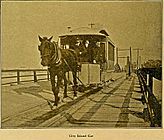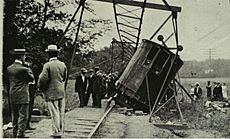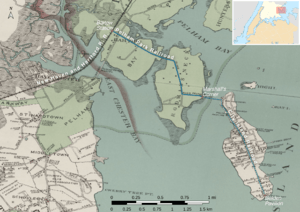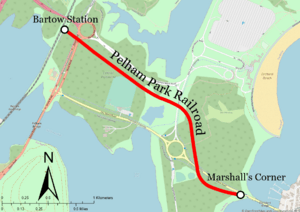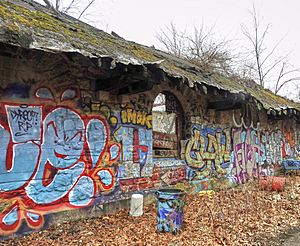Pelham Park and City Island Railway facts for kids
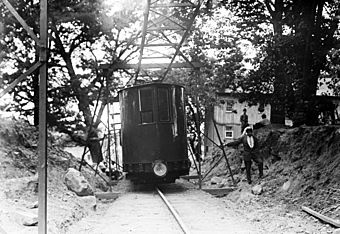
Exterior view of City Island Railroad car, c. 1910
|
|
| Overview | |
|---|---|
| Locale | the Bronx, New York City |
| Dates of operation | 1884 as two companies 1913 merger–1914 |
| Predecessor | Pelham Park Railroad Company City Island Railroad |
| Successor | Third Avenue Railway |
| Technical | |
| Track gauge | 4 ft 8 1⁄2 in (1,435 mm) |
| Previous gauge | 3 ft 6 in (1,067 mm) and monorail |
The Pelham Park and City Island Railway was a short train line in the Bronx, New York City. It connected City Island to the mainland at Bartow station. This railway existed from 1884 to 1919. For most of its life, it used horses to pull its cars. In 1910, the mainland part of the line changed to an electric monorail. This was very special because it was the only one of its kind in the United States back then. People nicknamed it The Flying Lady. Before this railway, people traveled between City Island and Mount Vernon by stagecoach.
The railway had two serious accidents. One happened when it was still horse-drawn. The second occurred on the very first day the monorail started running. The line never made much money and eventually closed down because the company went bankrupt.
Contents
Early Travel to City Island
Before the railway, people used a stagecoach service. Robert Vickery ran one between Mount Vernon and City Island until 1887. Another stagecoach was run by two brothers who owned a grocery store on the island. They used it to deliver groceries to people living there.
Horse-Drawn Railway
The railway started as two separate companies on August 30, 1884. These were the Pelham Park Railroad Company and the City Island Railroad. They met at Marshall's Corner, close to the bridge leading to City Island. At that time, the area was part of the Town of Pelham in Westchester County.
The Pelham Park Railroad Company operated a narrow gauge system. Its tracks were 3 ft 6 in (1,067 mm) wide. The line opened from the Cass Gilbert-designed Bartow station to Marshall's Corner on May 20, 1887. Just five days later, it extended across the bridge to City Island. It went along City Island Avenue to Brown's Hotel. By 1892, the line reached Belden's Point, its final stop. The total length of both lines combined was about 3.2 miles (5.1 km).
On April 8, 1889, an accident happened. Many passengers had taken another train to Bartow station. From there, they switched to the horse-drawn cars for City Island. The railway used six passenger cars and two flatbed freight cars. About 50 to 60 passengers were riding on the freight cars, many of them standing. The first car overturned on a sharp curve near the City Island Bridge. Many people were hurt, some seriously. Officials said the driver might have been driving recklessly.
In 1895, New York City took over the area where the horse-drawn cars ran. This area is now known as the East Bronx. That same year, a City Island resident named Richard S. Williams complained. He said the two railway companies were charging passengers twice. He believed they should charge only one 5-cent fare, not 5 cents for each company.
In 1902, the Interborough Rapid Transit Company (IRT) took control of both railway companies. The IRT later became famous for operating the first line of the New York City Subway. The IRT bought the City Island Railroad for $4.5 million. They planned to expand it to connect with other new train lines.
The Monorail Era
An inventor named Howard Hansel Tunis showed off an experimental monorail in Virginia in 1907. The Pelham Park Railroad was very impressed. They wanted to build their own monorail with help from Tunis's company. The planned monorail cars were 50 feet (15 meters) long and 6.5 feet (2 meters) wide. They had pointed ends. The cars would ride on a single rail with four wheels. Two more sets of wheels on top of the car would connect to an overhead guide rail. People thought these cars could go very fast, maybe 80 to 100 miles per hour (129 to 161 km/h). The trip from Bartow Station to City Island would take only 3 to 5 minutes, much faster than the 40-minute horse-drawn trip.
City Island residents had complained a lot about the horse-drawn service. One newspaper even joked that the cars were off the rails almost as much as they were on them! In October 1908, the railway asked for permission to switch from horses to electric power. They got approval in November. This new monorail would be the first commercial monorail in New York City. It was also the only one in the United States at that time.
How the Monorail Operated
The monorail started regular service in mid-July 1910. It had one car, nicknamed The Flying Lady. This car could reach speeds of 50 to 60 miles per hour (80 to 97 km/h). It was reported to be 75 feet (23 meters) long and was either yellow or orange. Electric power came from two overhead rails, which also helped keep the car stable.
On its very first trip, the car tipped over while going around a curve. There were 100 passengers on board, which was more than twice its normal capacity of 40 people. Several passengers were injured, and one was hurt seriously. Howard Tunis, who was driving the monorail, broke a rib. His 6-year-old daughter also got bruises.
Tunis said the accident happened because the track was "cheaply built." He explained that the track sank several inches under the car's weight. This caused the car to lose contact with the upper rails. The accident happened near the power house, so an engineer quickly cut the electricity.
Operations stopped right away. Service started again on November 14, 1910. However, the monorail was not successful financially. The IRT forced the companies into bankruptcy on December 4, 1911. The monorail and the horse-drawn line continued to run until 1914.
Changing to Standard Tracks
In 1913, the IRT decided to change the railway tracks to a wider, standard size. They also planned to make it an electric trolley system. To do this, they combined the two old companies into a new one called the Pelham Park and City Island Railroad. This new company took over on July 1, 1913. The tracks on City Island and across the bridge were changed to standard gauge. Other horse-drawn cars were used for service. The monorail stopped running on April 3, 1914. For a short time, a bus provided service instead.
On July 9, 1914, the IRT sold the company to the Third Avenue Railway. The Third Avenue Railway quickly finished building the standard gauge tracks. However, they did not install overhead electric wires. The very last horse-drawn car in the Bronx ran on August 18, 1914. On the same day, the first battery-powered car started operating from Bartow to City Island.
End of Service
In 1919, the Third Avenue Railway asked for permission to close the line. They said they didn't have enough money to keep it running. They were given permission, and the railway stopped operating on August 9, 1919. New York City Mayor John Francis Hylan also agreed with closing it. He noted that the railway was losing almost $18,000 each year. He suggested selling the equipment to "junk dealers."
As of 2022, Bartow Station is no longer used and is in very poor condition. Parts of the roof are missing, and trees have grown into the building, causing damage. The walls are covered in graffiti.


